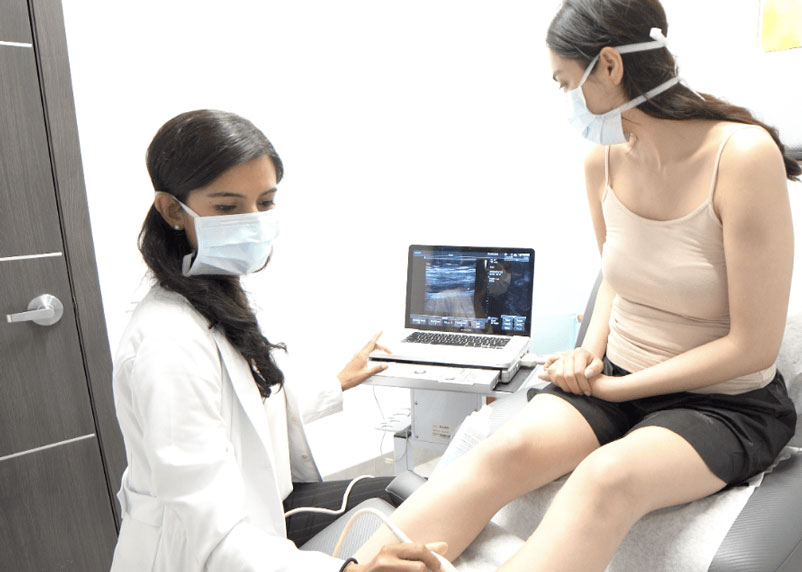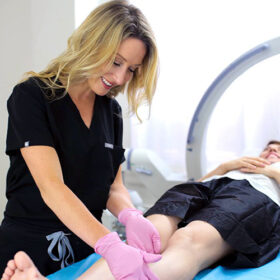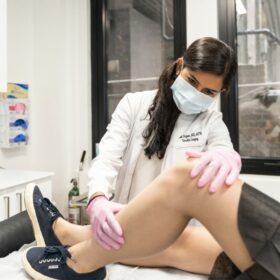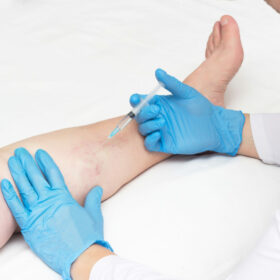If you are experiencing discomfort, pain, or swelling in your legs, you may be suffering from venous insufficiency. This is a medical condition that occurs when your blood vessels fail to properly circulate blood from your legs back to your heart. If left untreated, venous insufficiency can lead to varicose veins, deep vein thrombosis, and other serious health problems. But don’t worry, Vein Treatment Clinic is here to help. In this article, we will explain what venous insufficiency is and how we can help you fix it.
What is Chronic Venous Insufficiency (CVI)?
Venous insufficiency is a condition that affects the blood vessels in your legs, particularly in the veins that carry blood back to your heart. The valves in your veins help keep blood flowing in the right direction, but when these valves are damaged or weakened, blood can pool in the veins and cause a range of symptoms.
When your veins are healthy, blood flows smoothly from your legs back to your heart. However, if the valves in your veins are not working properly, blood can flow back down towards your feet and cause the veins to become swollen and enlarged. This can lead to a range of symptoms, including pain, swelling, itching, and fatigue in the legs. In more severe cases, venous insufficiency can also cause skin ulcers or blood clots, which can be dangerous if left untreated.
What Causes Venous Insufficiency?
There are several factors that can contribute to the development of venous insufficiency. Some of the most common include:
- Age: As you get older, the valves in your blood vessels may weaken, making it harder for blood to flow properly.
- Family history: If other members of your family have had venous insufficiency, you may be more likely to develop it as well.
- Medical history: If you have had blood clots in the past or other medical conditions that affect your blood vessels, you may be at higher risk for venous insufficiency.
- Lifestyle factors: Sitting or standing for long periods of time, being overweight, and not getting enough exercise can all contribute to the development of venous insufficiency.
How Do We Diagnose Venous Insufficiency?
At the Vein Treatment Clinic, we always start by performing a thorough medical evaluation, including a review of your medical history and a physical exam. We may also use vascular imaging and duplex ultrasound to get a detailed picture of your blood vessels and identify any problem areas. Once we have diagnosed your venous insufficiency, we will work with you to develop a personalized treatment plan.
How Do We Fix Venous Insufficiency?
At Vein Treatment Clinic, we provide a variety of minimally invasive procedures that are designed to treat venous insufficiency and its symptoms. These procedures include endovenous laser ablation, radiofrequency ablation, and VenaSeal.
- Endovenous Laser Ablation: Endovenous laser ablation (EVLA) is a minimally invasive procedure that uses laser energy to heat and close off problem veins. During the procedure, a small catheter is inserted into the affected vein, and a laser fiber is threaded through the catheter. The laser is then activated, which heats the vein and causes it to collapse. Blood is then rerouted through healthy veins, and the treated vein is gradually absorbed by the body.
- Radiofrequency Ablation: Radiofrequency ablation (RFA) is a similar procedure to EVLA, but instead of laser energy, it uses radiofrequency energy to close off problem veins. During the procedure, a small catheter is inserted into the affected vein, and a special device is used to generate heat and close off the vein. Blood is then rerouted through healthy veins, and the treated vein is gradually absorbed by the body.
- VenaSeal: VenaSeal is a unique procedure that involves injecting a special medical adhesive into problem veins to seal them off. This adhesive works by sealing the vein shut and rerouting blood through healthy veins. VenaSeal is a quick, virtually painless procedure that can be performed in under an hour, and it requires little to no downtime.
All of these procedures are minimally invasive, meaning they involve only small incisions or injections and require little to no downtime. They are also highly effective, with success rates of up to 98%. In addition to these procedures, we may also recommend compression therapy or the use of compression socks to help improve blood flow and reduce swelling. We may also suggest lifestyle changes such as getting more exercise, losing weight, and avoiding long periods of sitting or standing.
How Can You Prevent Venous Insufficiency?
While there is no guaranteed way to prevent venous insufficiency, there are several steps you can take to reduce your risk. These include:
- Getting regular exercise to improve blood flow and strengthen your veins.
- Maintaining a healthy weight to reduce pressure on your veins and improve overall circulation.
- Avoiding sitting or standing for long periods of time. If you have a desk job, try to take regular breaks to stand up, stretch, and move around.
- Wearing compression socks or stockings, especially if you are at high risk for venous insufficiency or have a family history of the condition.
- Elevating your legs whenever possible, especially after long periods of sitting or standing.
- Taking regular breaks during long flights or car rides to move around and improve blood flow.
- Managing other medical conditions that can contribute to venous insufficiency, such as obesity or diabetes.
Contact VTC For Minimally Invasive Procedures
Venous insufficiency is a common medical condition that can cause discomfort, pain, and other unpleasant symptoms. Fortunately, at Vein Treatment Clinic, we offer a variety of minimally invasive procedures that can help fix venous insufficiency and improve blood flow in your legs. Whether you are experiencing varicose veins, chronic venous insufficiency (CVI), or other related conditions, our team of board-certified vein doctors can work with you to develop a personalized treatment plan that fits your unique needs.
If you are experiencing symptoms of venous insufficiency or are concerned about your risk for the condition, don’t hesitate to contact us for a consultation. Our state-of-the-art locations across the United States, including New York, New Jersey, Long Island, California, and Washington DC, make it easy to get the help you need. With our diagnostic techniques, minimally invasive procedures, and expert care, we can help you get back to enjoying a healthy and active lifestyle.












